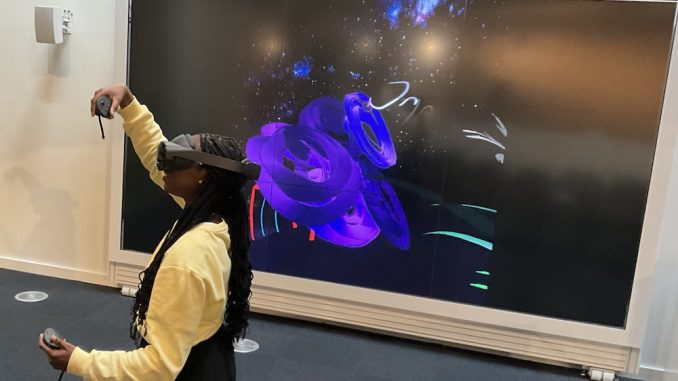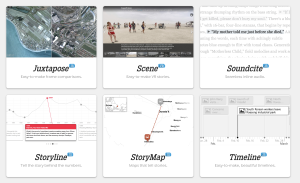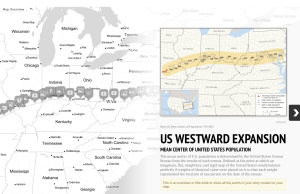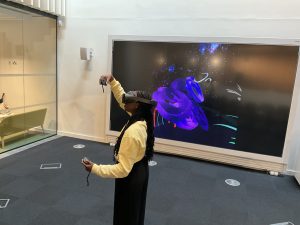Sessions on visualising data online, digital humanities theory, 3D art and sense of place in VR, and an update to WordPress adding the Zotpress plugin to link to Zotero.
Visualising Data Online
The DAHL Shorts sessions this week were led by Dr Bryan Brazeau of Liberal Arts. Bryan gave us a fast overview of a set of free web tools for DH by Knight Lab (Northwestern University). The tools make it easy to create explorable visualisations of historical, cultural, and geographical information.
We considered applications in teaching, public engagement, and research. Visualising your data in different ways may inspire new perspectives on a topic, even a familiar topic that has been explored many times before. These tools are beautifully presented and simple to use, meaning that researchers, students and members of the public can approach data with a playful and experimental spirit.
In the second part we focussed on the StoryMap tool, adding information to maps. For example:
Watch a recording of Bryan’s session:
Digital Humanities Theory
In 2022 Bryan gave a lecture for the DH Cert on DH theory. He recommended the following articles:
11704990
NEKA4E69
items
1
0
default
asc
1
750
https://www.inspireslearning.com/dahl/wp-content/plugins/zotpress/
%7B%22status%22%3A%22success%22%2C%22updateneeded%22%3Afalse%2C%22instance%22%3A%22zotpress-c4a846b085ff8e6c941c5004a3be832a%22%2C%22meta%22%3A%7B%22request_last%22%3A0%2C%22request_next%22%3A0%2C%22used_cache%22%3Atrue%7D%2C%22data%22%3A%5B%7B%22key%22%3A%22NEKA4E69%22%2C%22library%22%3A%7B%22id%22%3A11704990%7D%2C%22meta%22%3A%7B%22numChildren%22%3A2%7D%2C%22bib%22%3A%22%3Cdiv%20class%3D%5C%22csl-bib-body%5C%22%20style%3D%5C%22line-height%3A%202%3B%20padding-left%3A%201em%3B%20text-indent%3A-1em%3B%5C%22%3E%5Cn%20%20%3Cdiv%20class%3D%5C%22csl-entry%5C%22%3E%3Ci%3EProblems%20of%20Scale%20in%20%26%23x201C%3BClose%26%23x201D%3B%20and%20%26%23x201C%3BDistant%26%23x201D%3B%20Reading%20-%20ProQuest%3C%5C%2Fi%3E.%20%28n.d.%29.%20Retrieved%20May%2016%2C%202023%2C%20from%20%3Ca%20href%3D%27https%3A%5C%2F%5C%2Fwww.proquest.com%5C%2Fdocview%5C%2F1910289130%27%3Ehttps%3A%5C%2F%5C%2Fwww.proquest.com%5C%2Fdocview%5C%2F1910289130%3C%5C%2Fa%3E%20%3Ca%20title%3D%27Download%27%20class%3D%27zp-DownloadURL%27%20href%3D%27https%3A%5C%2F%5C%2Fwww.inspireslearning.com%5C%2Fdahl%5C%2Fwp-content%5C%2Fplugins%5C%2Fzotpress%5C%2Flib%5C%2Frequest%5C%2Frequest.dl.php%3Fapi_user_id%3D11704990%26amp%3Bdlkey%3DIELZHDRT%26amp%3Bcontent_type%3Dapplication%5C%2Fpdf%27%3EDownload%3C%5C%2Fa%3E%3C%5C%2Fdiv%3E%5Cn%3C%5C%2Fdiv%3E%22%2C%22data%22%3A%7B%22itemType%22%3A%22webpage%22%2C%22title%22%3A%22Problems%20of%20Scale%20in%20%5Cu201cClose%5Cu201d%20and%20%5Cu201cDistant%5Cu201d%20Reading%20-%20ProQuest%22%2C%22creators%22%3A%5B%5D%2C%22abstractNote%22%3A%22%22%2C%22date%22%3A%22%22%2C%22url%22%3A%22https%3A%5C%2F%5C%2Fwww.proquest.com%5C%2Fdocview%5C%2F1910289130%22%2C%22language%22%3A%22%22%2C%22collections%22%3A%5B%22SWWV3ZGI%22%5D%2C%22dateModified%22%3A%222023-05-16T07%3A34%3A20Z%22%7D%7D%5D%7D
Problems of Scale in “Close” and “Distant” Reading - ProQuest . (n.d.). Retrieved May 16, 2023, from
https://www.proquest.com/docview/1910289130 Download
11704990
RSGRLE8F
items
1
0
default
asc
1
750
https://www.inspireslearning.com/dahl/wp-content/plugins/zotpress/
%7B%22status%22%3A%22success%22%2C%22updateneeded%22%3Afalse%2C%22instance%22%3A%22zotpress-453b0ed0586994e0a3187898e821017c%22%2C%22meta%22%3A%7B%22request_last%22%3A0%2C%22request_next%22%3A0%2C%22used_cache%22%3Atrue%7D%2C%22data%22%3A%5B%7B%22key%22%3A%22RSGRLE8F%22%2C%22library%22%3A%7B%22id%22%3A11704990%7D%2C%22meta%22%3A%7B%22creatorSummary%22%3A%22Kirschenbaum%22%2C%22parsedDate%22%3A%222010%22%2C%22numChildren%22%3A1%7D%2C%22bib%22%3A%22%3Cdiv%20class%3D%5C%22csl-bib-body%5C%22%20style%3D%5C%22line-height%3A%202%3B%20padding-left%3A%201em%3B%20text-indent%3A-1em%3B%5C%22%3E%5Cn%20%20%3Cdiv%20class%3D%5C%22csl-entry%5C%22%3EKirschenbaum%2C%20M.%20G.%20%282010%29.%20What%20Is%20Digital%20Humanities%20and%20What%26%23x2019%3Bs%20It%20Doing%20in%20English%20Departments%3F%20%3Ci%3EADE%20Bulletin%3C%5C%2Fi%3E%2C%20%3Ci%3E150%3C%5C%2Fi%3E.%20%3Ca%20title%3D%27Download%27%20class%3D%27zp-DownloadURL%27%20href%3D%27https%3A%5C%2F%5C%2Fwww.inspireslearning.com%5C%2Fdahl%5C%2Fwp-content%5C%2Fplugins%5C%2Fzotpress%5C%2Flib%5C%2Frequest%5C%2Frequest.dl.php%3Fapi_user_id%3D11704990%26amp%3Bdlkey%3DS66VDJBL%26amp%3Bcontent_type%3Dapplication%5C%2Fpdf%27%3EDownload%3C%5C%2Fa%3E%3C%5C%2Fdiv%3E%5Cn%3C%5C%2Fdiv%3E%22%2C%22data%22%3A%7B%22itemType%22%3A%22journalArticle%22%2C%22title%22%3A%22What%20Is%20Digital%20Humanities%20and%20What%5Cu2019s%20It%20Doing%20in%20English%20Departments%3F%22%2C%22creators%22%3A%5B%7B%22creatorType%22%3A%22author%22%2C%22firstName%22%3A%22Matthew%20G%22%2C%22lastName%22%3A%22Kirschenbaum%22%7D%5D%2C%22abstractNote%22%3A%22%22%2C%22date%22%3A%222010%22%2C%22language%22%3A%22en%22%2C%22DOI%22%3A%22%22%2C%22ISSN%22%3A%22%22%2C%22url%22%3A%22%22%2C%22collections%22%3A%5B%22SWWV3ZGI%22%5D%2C%22dateModified%22%3A%222023-05-16T07%3A36%3A33Z%22%7D%7D%5D%7D
Kirschenbaum, M. G. (2010). What Is Digital Humanities and What’s It Doing in English Departments?
ADE Bulletin ,
150 .
Download
11704990
QMXTM92Z
items
1
0
default
asc
1
750
https://www.inspireslearning.com/dahl/wp-content/plugins/zotpress/
%7B%22status%22%3A%22success%22%2C%22updateneeded%22%3Afalse%2C%22instance%22%3A%22zotpress-090f0fa80b951273977ba8691972cf9e%22%2C%22meta%22%3A%7B%22request_last%22%3A0%2C%22request_next%22%3A0%2C%22used_cache%22%3Atrue%7D%2C%22data%22%3A%5B%7B%22key%22%3A%22QMXTM92Z%22%2C%22library%22%3A%7B%22id%22%3A11704990%7D%2C%22meta%22%3A%7B%22numChildren%22%3A2%7D%2C%22bib%22%3A%22%3Cdiv%20class%3D%5C%22csl-bib-body%5C%22%20style%3D%5C%22line-height%3A%202%3B%20padding-left%3A%201em%3B%20text-indent%3A-1em%3B%5C%22%3E%5Cn%20%20%3Cdiv%20class%3D%5C%22csl-entry%5C%22%3E%3Ci%3E%5C%22The%20Dark%20Side%20of%20the%20Digital%20Humanities%20%7C%20Wendy%20Hui%20Kyong%20Chun%2C%20Richard%20Grusin%2C%20Patrick%20Jagoda%2C%20and%20Rita%20Raley%26%23x201D%3B%20in%20%26%23x201C%3BDebates%20in%20the%20Digital%20Humanities%202016%26%23x201D%3B%20on%20Debates%20in%20the%20DH%20Manifold%3C%5C%2Fi%3E.%20%28n.d.%29.%20Debates%20in%20the%20Digital%20Humanities.%20Retrieved%20May%2016%2C%202023%2C%20from%20%3Ca%20href%3D%27https%3A%5C%2F%5C%2Fdhdebates.gc.cuny.edu%5C%2Fread%5C%2Funtitled%5C%2Fsection%5C%2Fca35736b-0020-4ac6-9ce7-88c6e9ff1bba%27%3Ehttps%3A%5C%2F%5C%2Fdhdebates.gc.cuny.edu%5C%2Fread%5C%2Funtitled%5C%2Fsection%5C%2Fca35736b-0020-4ac6-9ce7-88c6e9ff1bba%3C%5C%2Fa%3E%20%3Ca%20title%3D%27Download%27%20class%3D%27zp-DownloadURL%27%20href%3D%27https%3A%5C%2F%5C%2Fwww.inspireslearning.com%5C%2Fdahl%5C%2Fwp-content%5C%2Fplugins%5C%2Fzotpress%5C%2Flib%5C%2Frequest%5C%2Frequest.dl.php%3Fapi_user_id%3D11704990%26amp%3Bdlkey%3DEVK5EED2%26amp%3Bcontent_type%3Dapplication%5C%2Fpdf%27%3EDownload%3C%5C%2Fa%3E%3C%5C%2Fdiv%3E%5Cn%3C%5C%2Fdiv%3E%22%2C%22data%22%3A%7B%22itemType%22%3A%22webpage%22%2C%22title%22%3A%22%5C%22The%20Dark%20Side%20of%20the%20Digital%20Humanities%20%7C%20Wendy%20Hui%20Kyong%20Chun%2C%20Richard%20Grusin%2C%20Patrick%20Jagoda%2C%20and%20Rita%20Raley%5Cu201d%20in%20%5Cu201cDebates%20in%20the%20Digital%20Humanities%202016%5Cu201d%20on%20Debates%20in%20the%20DH%20Manifold%22%2C%22creators%22%3A%5B%5D%2C%22abstractNote%22%3A%22Start%20reading%20this%20text%20on%20Debates%20in%20the%20DH%20Manifold%22%2C%22date%22%3A%22%22%2C%22url%22%3A%22https%3A%5C%2F%5C%2Fdhdebates.gc.cuny.edu%5C%2Fread%5C%2Funtitled%5C%2Fsection%5C%2Fca35736b-0020-4ac6-9ce7-88c6e9ff1bba%22%2C%22language%22%3A%22en-US%22%2C%22collections%22%3A%5B%22SWWV3ZGI%22%5D%2C%22dateModified%22%3A%222023-05-16T07%3A41%3A16Z%22%7D%7D%5D%7D
"The Dark Side of the Digital Humanities | Wendy Hui Kyong Chun, Richard Grusin, Patrick Jagoda, and Rita Raley” in “Debates in the Digital Humanities 2016” on Debates in the DH Manifold . (n.d.). Debates in the Digital Humanities. Retrieved May 16, 2023, from
https://dhdebates.gc.cuny.edu/read/untitled/section/ca35736b-0020-4ac6-9ce7-88c6e9ff1bba Download
11704990
N46YE4WG
items
1
0
default
asc
1
750
https://www.inspireslearning.com/dahl/wp-content/plugins/zotpress/
%7B%22status%22%3A%22success%22%2C%22updateneeded%22%3Afalse%2C%22instance%22%3A%22zotpress-a34569d71b60c9f11c474e92d1c4eeae%22%2C%22meta%22%3A%7B%22request_last%22%3A0%2C%22request_next%22%3A0%2C%22used_cache%22%3Atrue%7D%2C%22data%22%3A%5B%7B%22key%22%3A%22N46YE4WG%22%2C%22library%22%3A%7B%22id%22%3A11704990%7D%2C%22meta%22%3A%7B%22creatorSummary%22%3A%22Dimock%22%2C%22parsedDate%22%3A%222006%22%2C%22numChildren%22%3A1%7D%2C%22bib%22%3A%22%3Cdiv%20class%3D%5C%22csl-bib-body%5C%22%20style%3D%5C%22line-height%3A%202%3B%20padding-left%3A%201em%3B%20text-indent%3A-1em%3B%5C%22%3E%5Cn%20%20%3Cdiv%20class%3D%5C%22csl-entry%5C%22%3EDimock%2C%20W.%20%282006%29.%20Genre%20as%20World%20System%3A%20Epic%20and%20Novel%20on%20Four%20Continents.%20%3Ci%3ENarrative%3C%5C%2Fi%3E%2C%20%3Ci%3E14%3C%5C%2Fi%3E%281%29%2C%2085%26%23x2013%3B101.%20%3Ca%20href%3D%27https%3A%5C%2F%5C%2Fdoi.org%5C%2F10.1353%5C%2Fnar.2005.0025%27%3Ehttps%3A%5C%2F%5C%2Fdoi.org%5C%2F10.1353%5C%2Fnar.2005.0025%3C%5C%2Fa%3E%20%3Ca%20title%3D%27Download%27%20class%3D%27zp-DownloadURL%27%20href%3D%27https%3A%5C%2F%5C%2Fwww.inspireslearning.com%5C%2Fdahl%5C%2Fwp-content%5C%2Fplugins%5C%2Fzotpress%5C%2Flib%5C%2Frequest%5C%2Frequest.dl.php%3Fapi_user_id%3D11704990%26amp%3Bdlkey%3D3AF6LRST%26amp%3Bcontent_type%3Dapplication%5C%2Fpdf%27%3EDownload%3C%5C%2Fa%3E%3C%5C%2Fdiv%3E%5Cn%3C%5C%2Fdiv%3E%22%2C%22data%22%3A%7B%22itemType%22%3A%22journalArticle%22%2C%22title%22%3A%22Genre%20as%20World%20System%3A%20Epic%20and%20Novel%20on%20Four%20Continents%22%2C%22creators%22%3A%5B%7B%22creatorType%22%3A%22author%22%2C%22firstName%22%3A%22Wai-chee%22%2C%22lastName%22%3A%22Dimock%22%7D%5D%2C%22abstractNote%22%3A%22%22%2C%22date%22%3A%222006%22%2C%22language%22%3A%22en%22%2C%22DOI%22%3A%2210.1353%5C%2Fnar.2005.0025%22%2C%22ISSN%22%3A%221538-974X%22%2C%22url%22%3A%22http%3A%5C%2F%5C%2Fmuse.jhu.edu%5C%2Fcontent%5C%2Fcrossref%5C%2Fjournals%5C%2Fnarrative%5C%2Fv014%5C%2F14.1dimock.html%22%2C%22collections%22%3A%5B%22SWWV3ZGI%22%5D%2C%22dateModified%22%3A%222023-05-16T07%3A43%3A35Z%22%7D%7D%5D%7D
Dimock, W. (2006). Genre as World System: Epic and Novel on Four Continents.
Narrative ,
14 (1), 85–101.
https://doi.org/10.1353/nar.2005.0025 Download
Watch a recording of the lecture:
VR Club
Creating 3D art and exploring the reality of the virtual sense of place
In the VR Club this week we used Google Tilt Brush to create a landscape of virtual 3D artworks. It is always a surprise to see people who have never used VR before able to go into the space and operate with quite complex controls and tools to create recognisable artworks. This shows just how effective the immersion is – it just seems natural. When people come out of VR they are able to describe the space as if it is real – it does seem real to them! When they go back into the same space, they report that it is immediately familiar, like a real space. As a philosopher of space, mind and aesthetics, I find this fascinating – not just for what it tells us about VR, but also as a way to explore Dasein .
Tilt Brush includes a wide range of painting, drawing, and sculpting tools. Some of its effects include 3D sound, which adds to the sense of it being real, even if the end products are sometimes quite surreal.
WordPress site updates – Zotero reference manager integration
After a vote by members we settled on using Zotero as our reference manager.
Thanks for the votes, here and on Twitter. I’ve got the Zotero account up and running, and enabled the Zotpress plugin for WordPress (not perfect, but works for most things we need to do). This allows for “shortcodes” to be added to posts and pages which automagically add individual references or lists of references from collections (it should also work with tags, but I haven’t managed to make that work yet).
You can see the bibliography appearing here, automagically created from the collections in the Zotero library: https://www.inspireslearning.com/dahl/bibliography/
And the references being used in articles like this one: https://www.inspireslearning.com/dahl/skills/reflecting-on-your-achievements-a-systematic-and-structured-approach/





Leave a Reply